
Original Link: https://www.anandtech.com/show/1897
ATI's Avivo Update - H.264 Acceleration & a Special Downloadable Surprise
by Anand Lal Shimpi on December 16, 2005 3:09 PM EST- Posted in
- GPUs
Whenever ATI tells us they have some announcements to make two weeks before the end of the year, we usually get a bit worried. The fact of the matter is that it is very rare for a company to release and ship new products this close to the end of a year, so we tend to get suspicious when new announcements happen like this. There is one exception, however - and that is software, or in this case, drivers.
Just earlier this month, ATI released their Catalyst 5.12 drivers, which offered support for dual core processors, but without any really tangible gains in performance as we found out. ATI had also alluded to the potential of another Catalyst release before the end of the year, and as their predictions would have it, Catalyst 5.13 is due out for release this coming Thursday (12/22/2005).
But Catalyst 5.13 doesn't promise improved gaming performance, better scaling from dual core processors or anything of that sort. Instead, Catalyst 5.13 is a little gift to Radeon X1000 owners from the Avivo team.
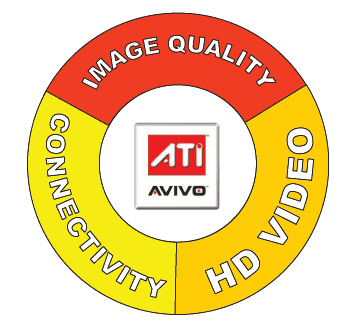
ATI promised us H.264 decode acceleration, offloading some of the most CPU intensive tasks for media PCs today onto their brand new GPUs. ATI also alluded to a transcode utility, which would aid in the conversion between video formats and potentially even accelerating it on the GPU as well.
Catalyst 5.13 begins to deliver on some of those promises of more, and while we had pretty much given up on Avivo being any good for DVD playback quality, ATI has also promised improved video playback in the latest version of Catalyst. While we'll save the video playback portion of this article for a later time, there are two equally important topics to discuss today instead. And there's one more surprise from ATI's Avivo team later on in the article as well...
H.264 Decode Acceleration - As Promised
One of the things that ATI had promised us was that by the end of the year, their Radeon X1000 series of GPUs would have hardware accelerated H.264 decode support; and with Catalyst 5.13, ATI is delivering on that promise.
Starting next Tuesday, Radeon X1000 owners will be able to download, for free, ATI's Catalyst 5.13 driver and a Cyberlink H.264 decoder that hooks into ATI's GPU and enables hardware acceleration of H.264. More specifically, ATI's Radeon X1000 GPU in combination with the Cyberlink H.264 decoder will handle the in-loop deblocking, motion compensation and inverse transform that occur during H.264 decoding. Unfortunately, ATI only had a beta ready for us in time for this review, so there were some bugs. Right now, ATI is hoping to have the final version available on the 22nd.
The end result is that CPU utilization is reduced, making the playback of H.264 movies possible on lower end systems and have less of a performance impact on all systems. ATI's work on H.264 decode acceleration today is extremely important because H.264 is the codec of choice for both Blu-ray and HD-DVD.
So how does it work? It's all fairly simple. You just install the Cyberlink H.264 decoder, which then lets you play, with ATI GPU acceleration, H.264 content in Windows Media Player. The bundle also includes an ATI skin for Windows Media Player, but thankfully, you can revert back to the original WMP skin.
The decoder will let you play all H.264 encoded movies, including H.264 Quicktime movies in Windows Media Player, and of course, they are all GPU accelerated. As you can guess, this only works on Radeon X1000 series GPUs.
Because H.264 decoding is an extremely processor intensive task, the level of acceleration that you can get varies based on what type of GPU you have. ATI tells us that the limitations are not artificial, and they are directly related to the number of functioning ALUs on the GPU (in other words, the more pixel pipes you have, the more processing power you have). The breakdown is pretty simple:

For our tests, we used a Radeon X1600 XT and paired it with some 720p content from Apple's Quicktime HD gallery. Unfortunately, due to the beta nature of the decoder, we couldn't get all of the content to work. ATI has told us that there are bound to be issues with the decoder, thanks to its beta state, but it is at least functional in most cases and the final version should be available next week.
Our test of choice was the third Chronicles of Narnia trailer from Apple's HD gallery. We used perfmon to record the CPU utilization on our testbed Athlon 64 3500+ and reported the minimun, average and maximum CPU utilization values during the playback of the trailer. Our reference point is our test bed running the trailer in Quicktime 7, which isn't GPU accelerated, and comparing that to Windows Media Player 10 with the Cyberlink H.264 decoder offloading some tasks to the GPU. While there are bound to be some differences between the two players, the majority of CPU time is spent in the decoder, so the variance between players is negligible.
| Decoder | Min | Avg | Max |
Quicktime (no Acceleration) |
18.8% | 53.1% | 78.1% |
| Cyberlink H.264 (GPU Acceleration) | 9.4% | 32.2% | 57.8% |
The average CPU utilization without ATI's GPU acceleration is a staggering 65% higher, not to mention that the peak CPU usage with GPU acceleration manages to stay under 60% while it otherwise hovers just below 80%.
While we didn't have a Radeon X1800 XT to test on hand, the benefits there should be even greater, since you can get GPU assisted decode at 1080p as well.
Introducing the Avivo Video Converter
The other item of interest that ATI briefed us on is the ATI Avivo Video Converter. We mentioned in our previous coverage that ATI was working on GPU accelerated video transcode, to speed up the conversion of videos from one format to another (e.g. MPEG-2 to H.264). Unfortunately, the GPU accelerated transcode isn't yet ready for debut, but what ATI is making available is the software front end for it.
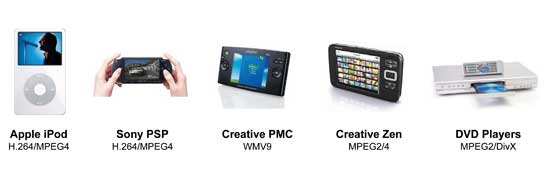

Click Start to continue
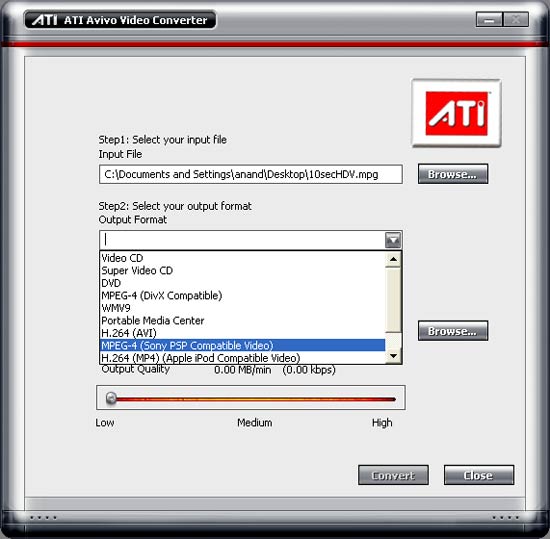
Select your input file and output format
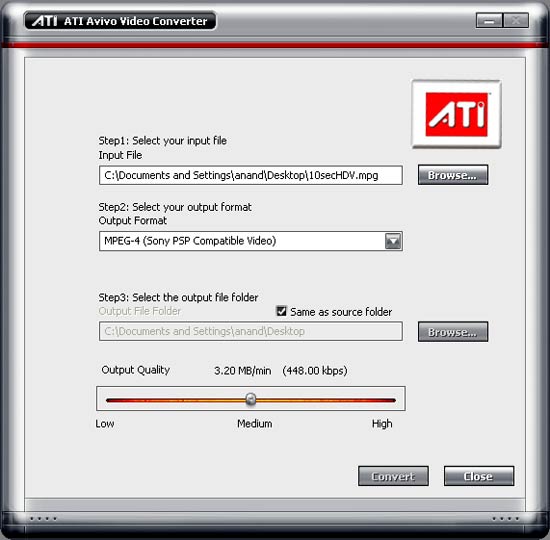
Next up, select your output quality and hit convert. The tool won't let you convert to an unsupported format (e.g. higher than 768kbps on the Sony PSP setting)
To see if ATI's tool was really more efficient, we took three source videos: a WMV HD trailer, an MPEG-1 file and a DivX file and converted them all to 768kbps MPEG-4 files for use on a Sony PSP. We measured the transcode time in minutes on our same Athlon 64 3500+ system and have reported the results below:
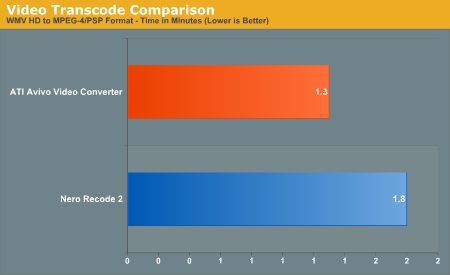
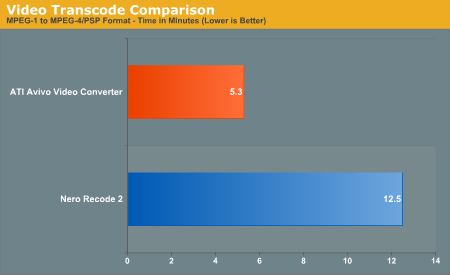
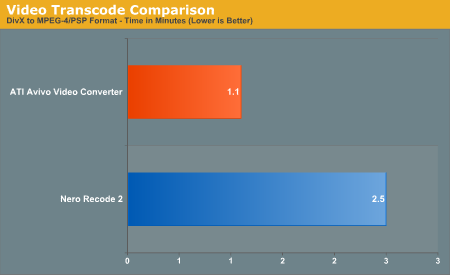
So, is ATI getting into the software business with the Avivo Video Converter? No. In fact, ATI is providing these algorithms and hooks to partners like Nero so that regardless of what software application you're using, you will get the best performance assuming that you have ATI hardware.
We should note that the Avivo Video Converter, despite not being GPU accelerated, will only work on ATI Radeon X1000 series of GPUs. ATI is still working on bringing a GPU accelerated version of the Avivo Video Converter to market, but that's still a while away.
ATI's Gift to X1000 Owners - Get the Avivo Video Converter, Today!
Last year, ATI was busy launching a bunch of cards that didn't make it to stores in time for the holidays, but thanks to the Avivo team, things are working a little different this time around. ATI has given us permission to distribute the beta Avivo Video Converter to our readers today under one condition - that we make it very clear that this converter is not supported by ATI, so don't complain if things don't work perfectly.
Despite that warning from ATI, we had fewer problems with the Avivo Video Converter than we did with the beta H.264 decoder - it's actually in amazingly good shape for unsupported, pre-release software.
The download is approximately 2.3MB zipped and you can get it here. Feel free to distribute it as you would like. Remember, it only works on ATI Radeon X1000 cards, but who knows - some of our more creative users may be able to find ways around that.
The other item we didn't touch on that makes its appearance in the Catalyst 5.13 drivers is significantly improved video playback quality. ATI didn't have all of their Avivo ducks in a row when the X1000 series launched, but with Catalyst 5.13 they are looking to improve a number of the issues we noted in our first Avivo video quality article. We will be working on a follow-up to that piece in the near future to take a look at exactly what Catalyst 5.13 brings us in terms of video quality.








